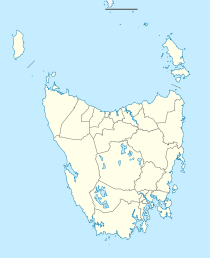Plenty, Tasmania facts for kids
Quick facts for kids PlentyTasmania |
|||||||||||||||
|---|---|---|---|---|---|---|---|---|---|---|---|---|---|---|---|
| Population | 93 (2016 census) | ||||||||||||||
| Postcode(s) | 7140 | ||||||||||||||
| Location | 9 km (6 mi) NW of New Norfolk | ||||||||||||||
| LGA(s) | Derwent Valley Council | ||||||||||||||
| Region | South-east | ||||||||||||||
| State electorate(s) | Lyons | ||||||||||||||
| Federal Division(s) | Lyons | ||||||||||||||
|
|||||||||||||||
Plenty is a small area in the Derwent Valley region of Tasmania, Australia. It is located about 9 kilometers (about 5.6 miles) north-west of the town of New Norfolk. In 2016, a census counted 93 people living in Plenty.
Plenty is also the name of a river that flows into the River Derwent. This area was once known for growing hops and for fishing. Today, Plenty is famous for the Salmon Ponds, which was the first fish hatchery built on the Plenty River in 1864. It is also home to the Tasmanian Museum of Trout Fishing.
Contents
Plenty's Past: A Look at History
Plenty became an official place name in 1959. A post office opened in the area in 1869, first called "River Plenty Post Office." It was renamed "Plenty" in 1895 and closed in 1956.
Bringing Trout to Australia
Plenty is very important because it was where brown trout were first brought to Australia. In 1864, 1,500 brown trout eggs were sent from the River Itchen in England. They traveled for four months by sailing ship to Melbourne. Only 300 eggs survived the long journey.
By 1866, 171 young brown trout were growing well in a hatchery on the Plenty River. Later that year, 38 young trout were released into the river. By 1868, the Plenty River had a healthy population of brown trout that could reproduce on their own. These fish then became the source for introducing brown trout to other rivers in Australia and New Zealand.
Atlantic Salmon: A Different Story
At the same time, efforts were made to introduce Atlantic salmon to Tasmania. Even though young Atlantic salmon were successfully raised in the Plenty River hatchery, they did not manage to create lasting populations in Tasmania or Australia.
Protecting the Plenty River
In 2020, there was a serious event involving the Plenty River. It was reported that harmful substances from a local composting business were released into the river. This incident sadly led to the death of over 100,000 fish.
The company makes compost by mixing waste from a paper mill, the salmon farming industry, and treated sewage. If this waste is not stored correctly, it can create harmful liquids that pollute the surrounding soil and water. The company faced consequences for causing environmental pollution and for not storing waste properly.
Plenty's Location and Rivers
The River Derwent forms the north-western and northern edges of Plenty. The Plenty River itself forms a small part of the southern boundary before flowing north through the area.


